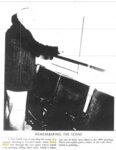


On Feb. 2, 1909, tensions were riding high in the district courtroom at the Coryell County Courthouse. A town divided had come to witness a much-discussed court case… that would never culminate with a verdict.
When multiple gun shots rang out in the packed courtroom, those assembled were scrambling to avoid the sudden spray of bullets fired by a woman who was “wronged” by the man who was on trial for seducing her. Inside the crowded courtroom, some spectators were sitting in the windowsills when the shots rang out. One of those people, fearing he would be shot, jumped from the second story window, falling to the ground and breaking his leg. In the end, four people had been shot in the courtroom. The one who died instantly was John Hanes, the defendant accused of seduction.
The story began in March 1907. Several versions of the story have often been embellished over the years. Verna Ware was an 18-year-old young lady of medium build with dark hair and dark eyes. She had become acquainted with John Hanes, a young man who was 22 years of age. One version of the story is that Hanes, who was said to have been a pharmacist, had secretly placed drugs in chocolates that he gave to Ware at a picnic, and after she was sedated, he took advantage of her. The other story, and most likely the more accurate version, was that Hanes had escorted Ware to a dance in the western regions of Coryell County where the two had ended up spending the night together, thus resulting in Ware becoming pregnant.
On Dec. 24, 1908, Verna Ware gave birth to a healthy baby girl whom she named Opal Kathryn. The exact relationship between Ware and John Hanes remains unknown, but the following month after her daughter’s birth, on January 23, 1909, seduction charges were filed against John Hanes. A deadly court case would ensue the following month. Both Verna and John came from well-known and respectable farm families. The community became divided… some coming to Verna’s defense and others to John’s.
On the day of the shooting, Verna Ware and her brother were standing in the rotunda of the courthouse watching the proceedings through an inside window which separated the courtroom from the rotunda. Some reports say that she feared that Hanes would not be convicted of seduction and that was when she took matters into her own hands. Before she could be stopped, Ware pulled a .38 Colt revolver from her purse and shot Hanes at least twice and then shot three other men in the courtroom who were said to be his character witnesses. Newspaper accounts said that after she had shot the men, she put the gun to her own head, but that the gun was wrestled away from her before she could fire.
Ware was taken to the Coryell County Jail where physicians reported her to be in a “critical condition of nervous collapse.” She had to wait in jail a few days before the grand jury could charge her. During that time, newspapers reported that there were “threats of violence” made against her by friends of John Hanes. One account reported that “a party was formed which threatened a lynching, but its leader was arrested, and the rest were dispersed by officers.”
The grand jury returned three bills of indictment for murder and one for carrying a pistol. Ware’s bond was set at $7,500 which was determined by $2,500 for each charge of murder. The bond was provided by prominent citizens of the community who sympathized with Ware and her condition.
Ware’s trial began in the latter part of 1909. In August, it was reported that the courtroom was filled to capacity with 120 men, visitors and witnesses. The window in the courtroom through which Ware had fired the fatal shots had been painted over and the sheriff had declared that everyone entering the courtroom would come through one door and no one with firearms of any kind would be permitted to enter.
The trial continued on until February 1910 when a verdict of “not guilty” was rendered by the jury. The judge had instructed the jury to deliberate the charges of first-degree murder, manslaughter and self-defense. Ware’s legal defense continued to press for a plea of insanity and irrepressible impulse, which apparently worked since newspapers reported that during the trial “many pathetic scenes took place that moved the jury and spectators alike to tears.”
The year following her vindication, Verna Ware married W.R. Eck in Gatesville when her daughter Opal was nearly three years of age. Opal believed W.R. Eck to be her father and would carry his name until she married. W.R., Verna and Opal would later live in the Dallas area before moving to Oklahoma and eventually, to Utah – far away from any memories that might haunt her.
Verna Ware Eck died on July 31, 1973, in Clearfield, Utah. Her obituary mentioned that she was a saleswoman and buyer for a clothing store. She was also a member of the Baptist Church and a member of the Business and Professional Women’s Club. Her only survivor was her daughter, Opal.